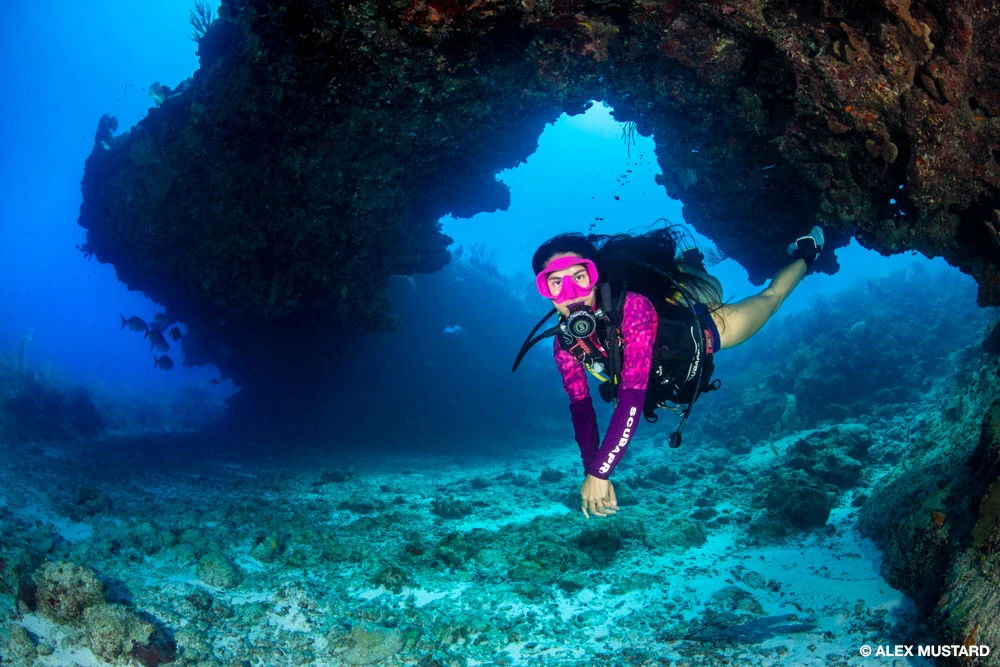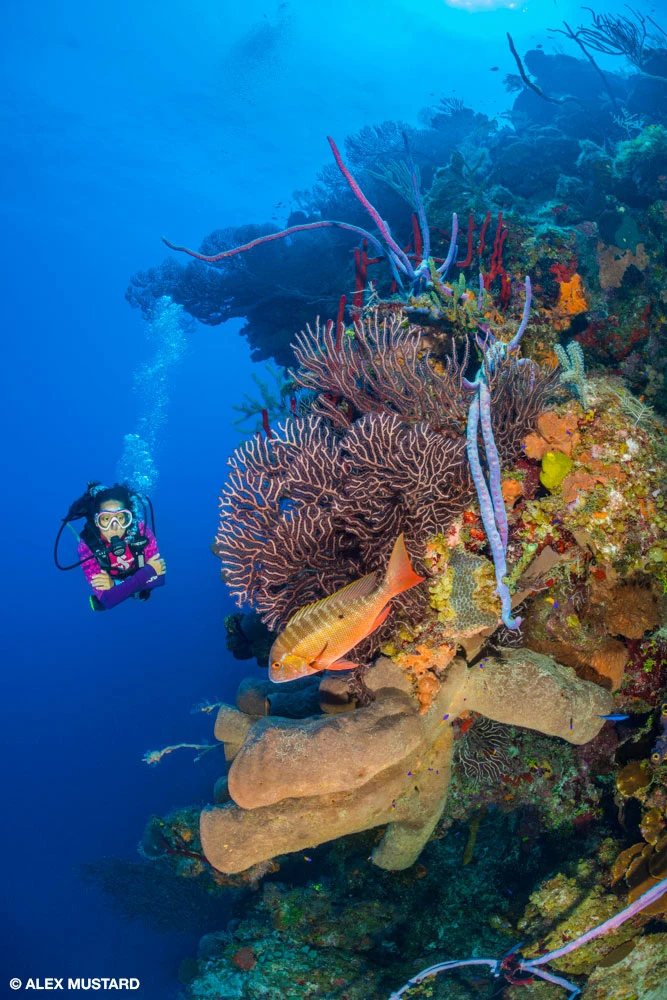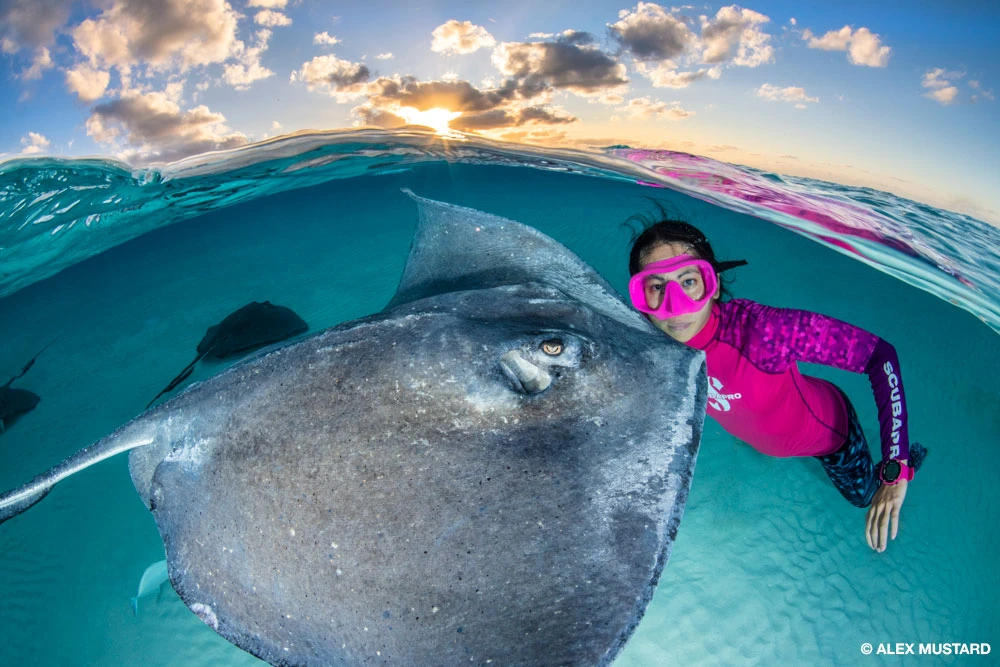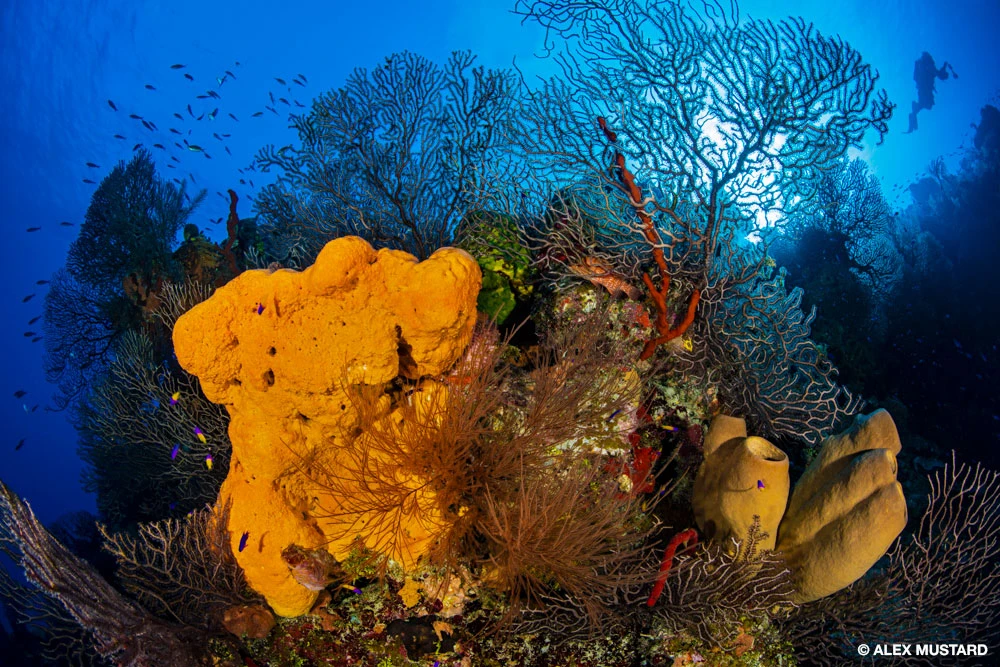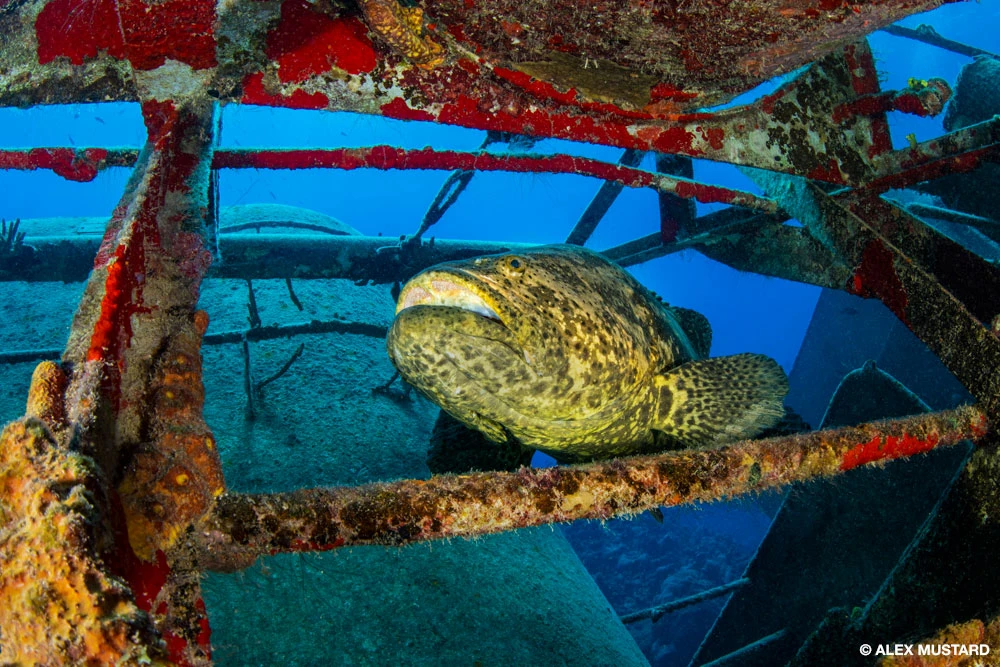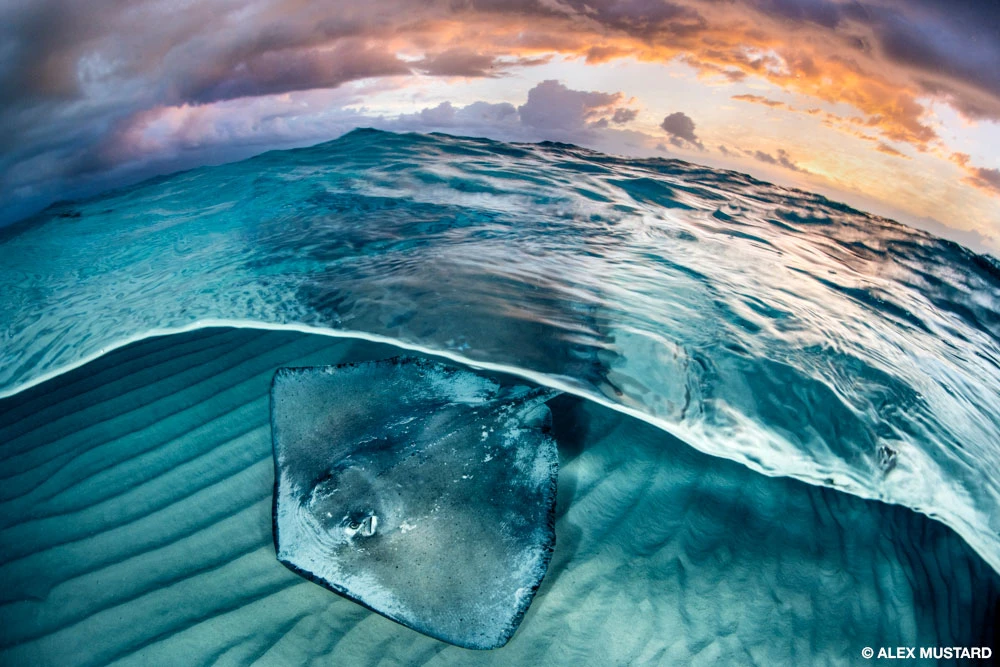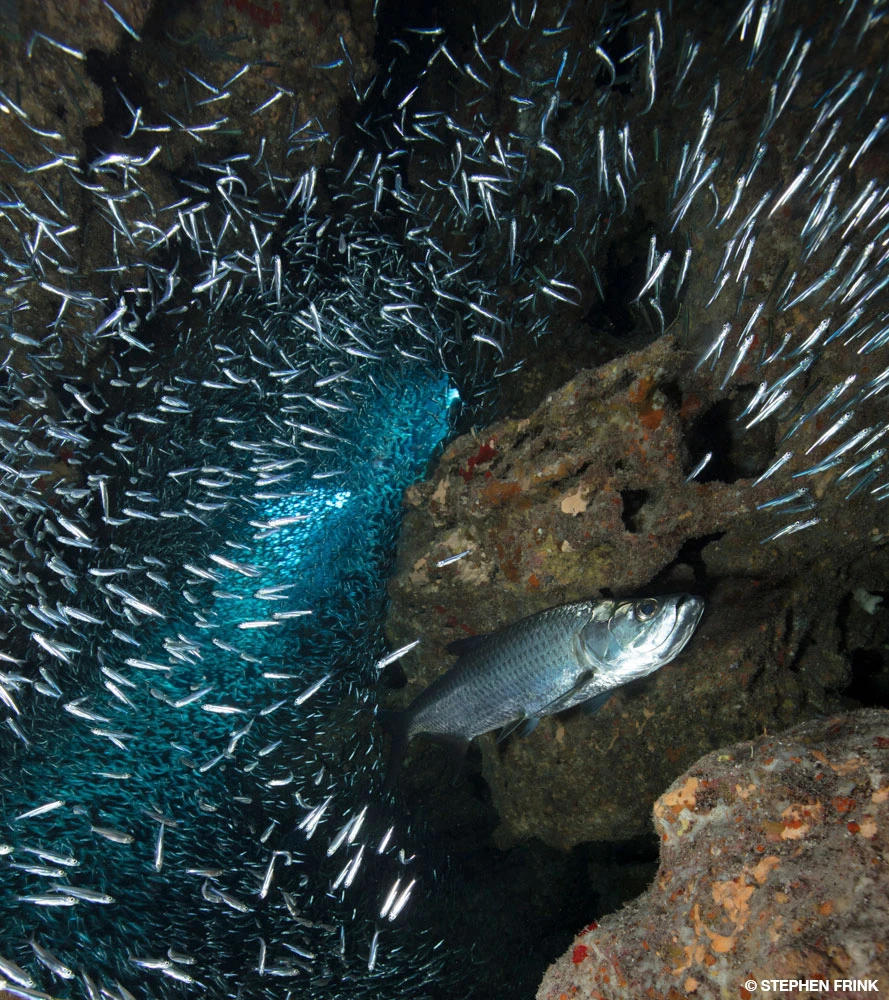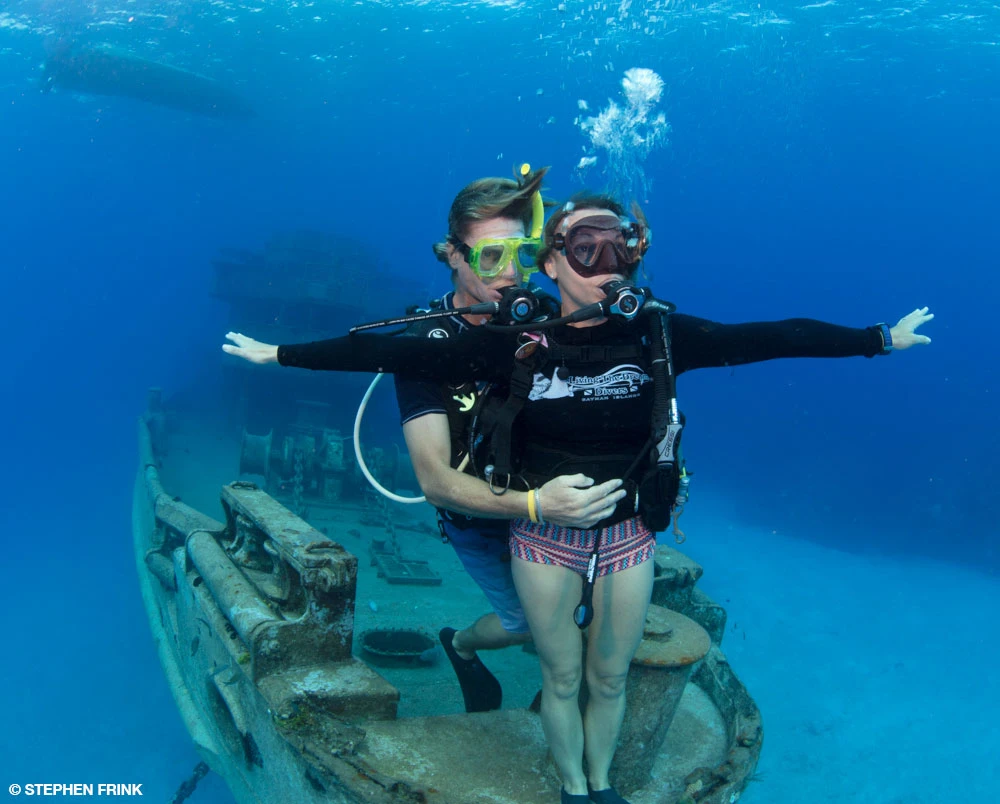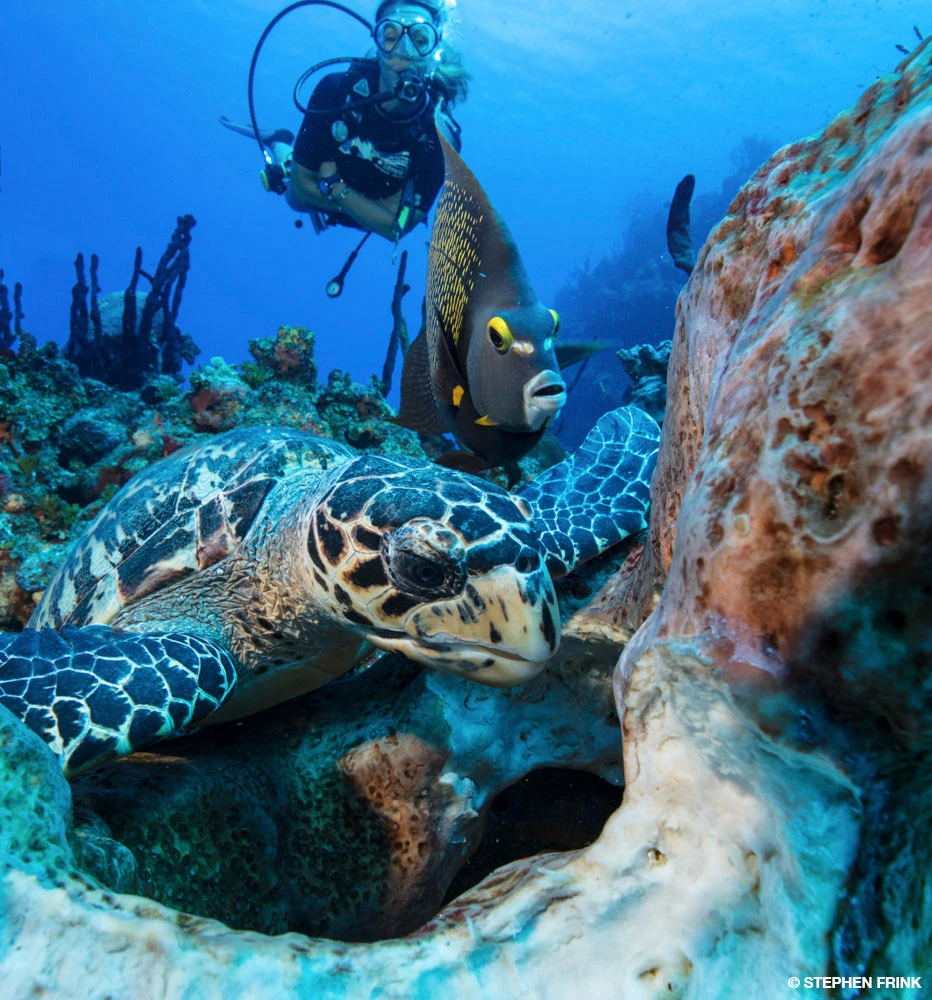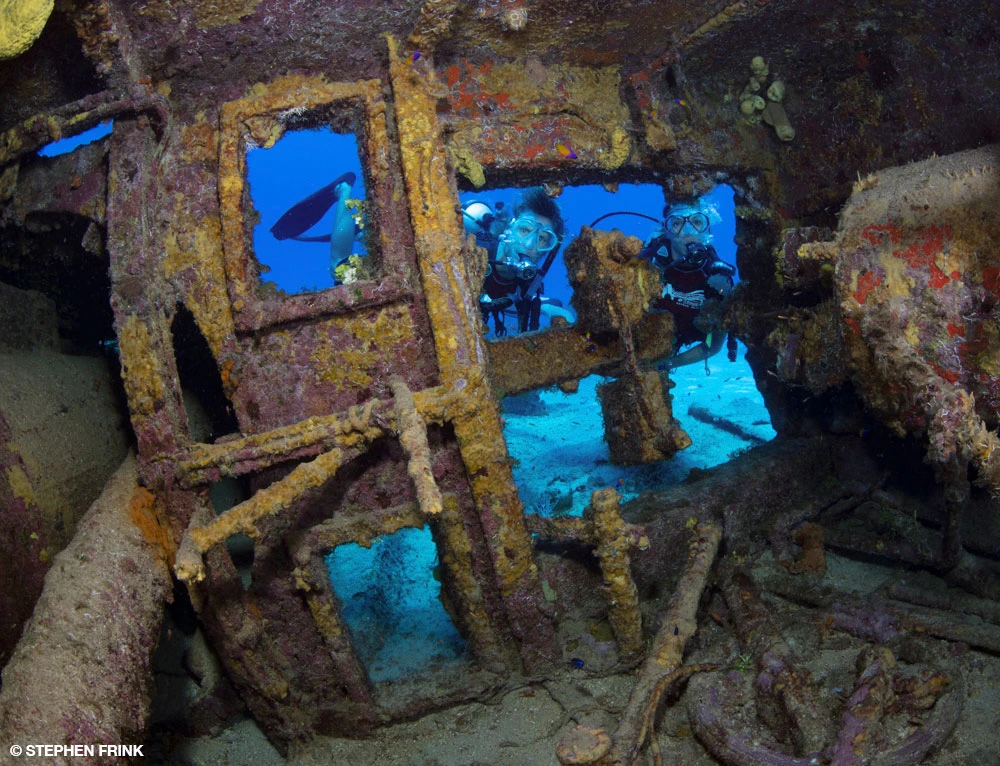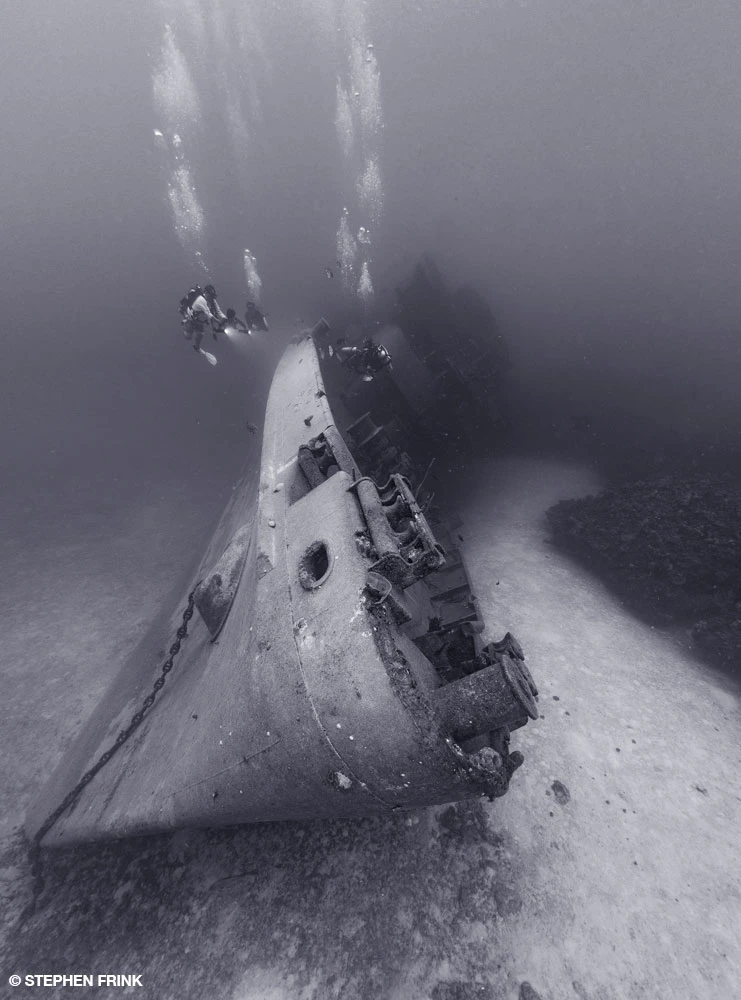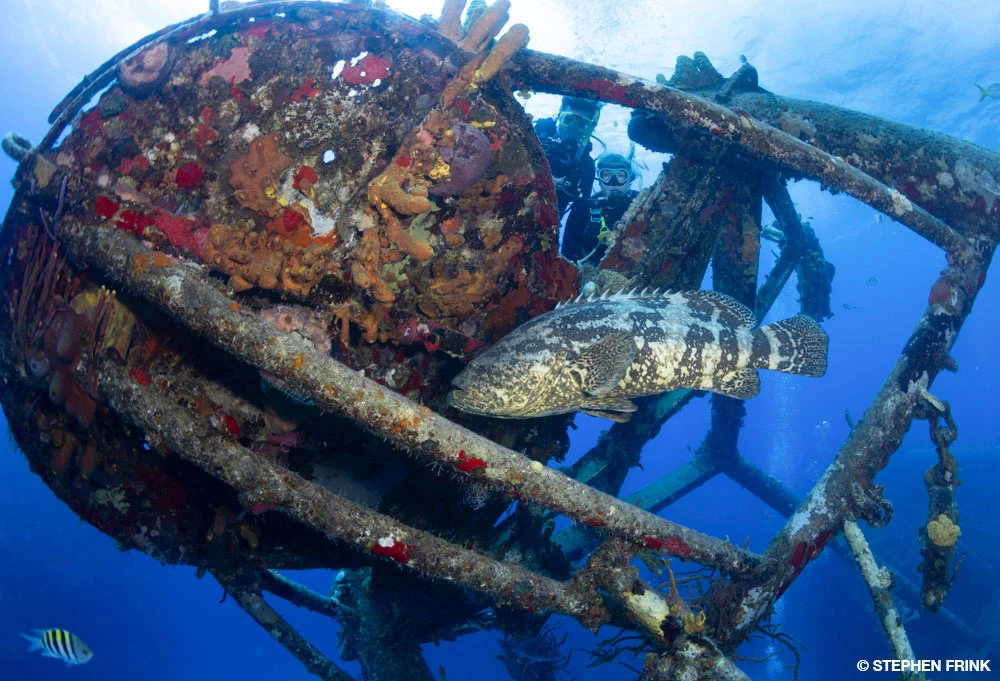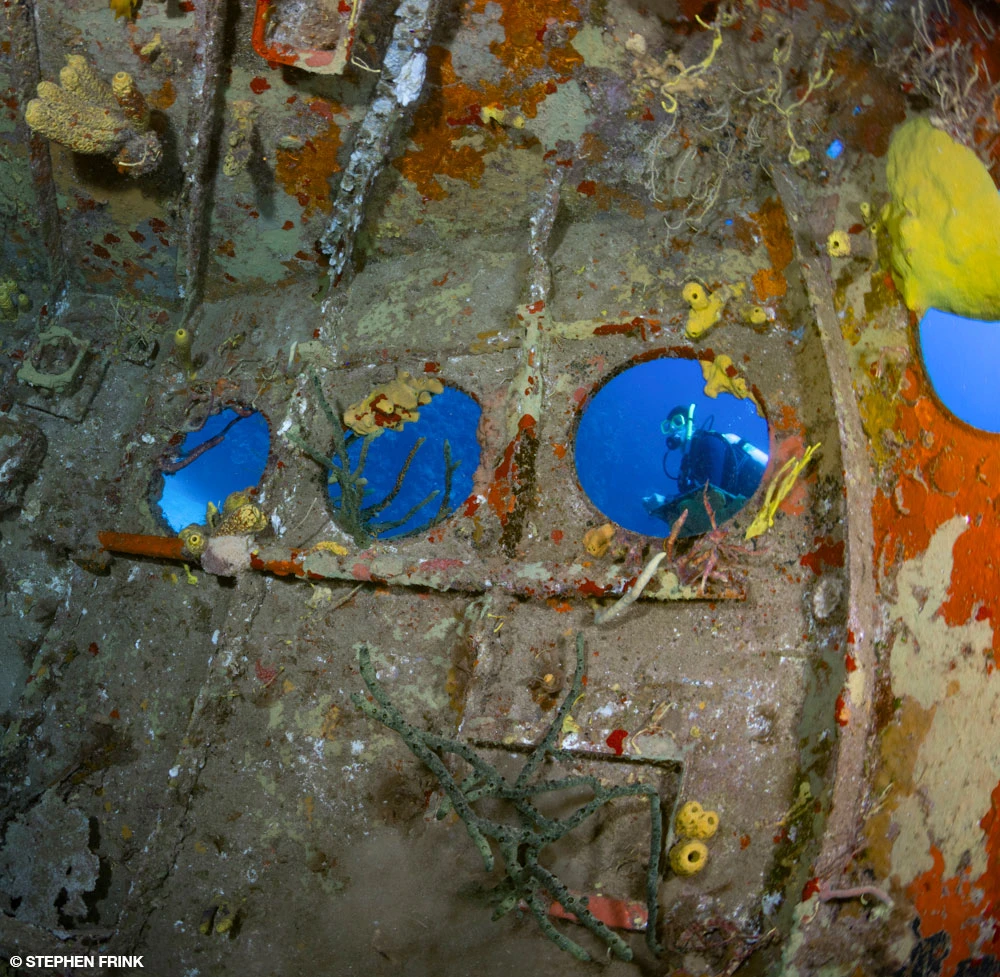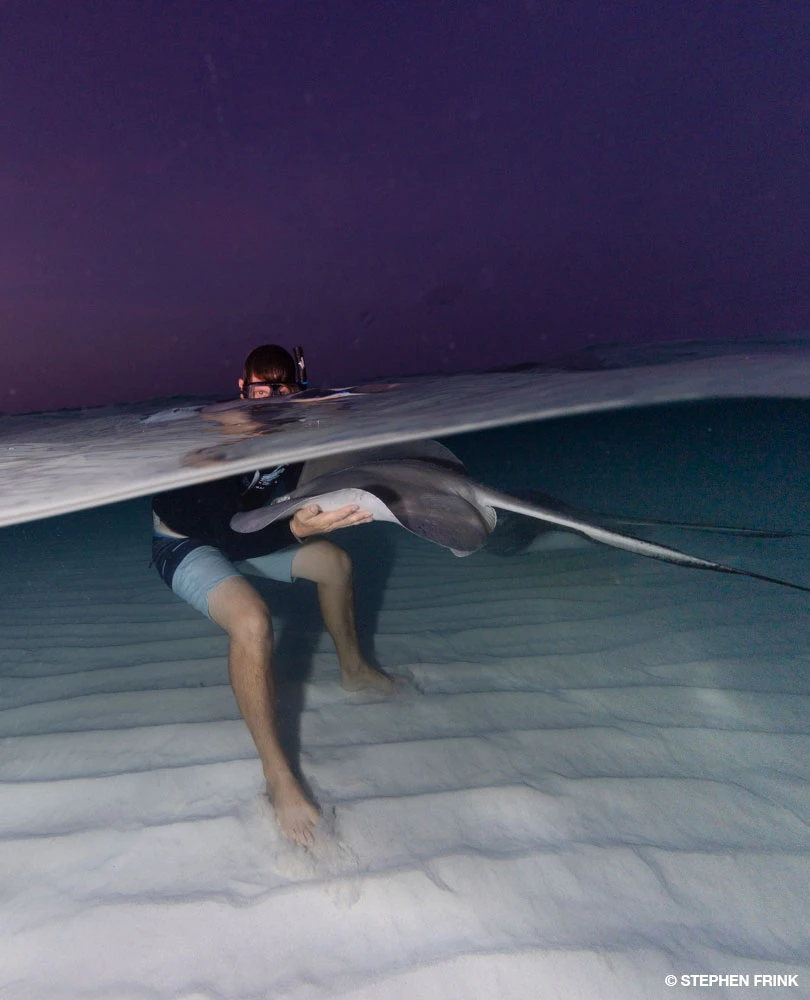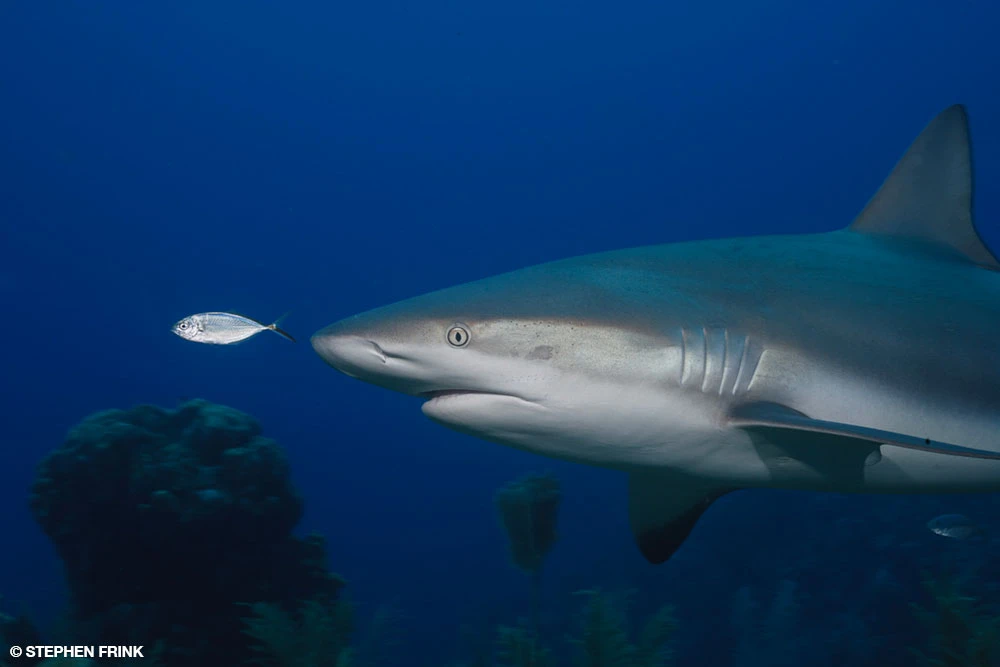Dive photojournalists often go to the same places but rarely at the same time. In 2006, however, Alex Mustard participated in an imaging event called Digital Madness,and I was there to cover it for a magazine. That was our only time diving together on Grand Cayman.
While it would have been fun to rendezvous 18 years later and experience each other’s perspectives on diving Grand Cayman while on the island together, we had to settle for sharing our recollections of one of our favorite Caribbean destinations. Mustard told his story with Grand Cayman in mind as a host venue for his underwater photography workshops, and I recalled the multiple advertising shoots I have staged there over the decades. The island remains an aspirational dive destination and has been good for our projects for the same reasons. — Stephen Frink
The Perfect Underwater Classroom
With a splash, the bright blue Caribbean water engulfs me. The stresses of daily life float away as I become weightless in the warm water. We exchange OK signals and are off, following the line down to the Kittiwake wreck. This purpose-sunk wreck has been underwater for more than 13 years and has become a great dive. It lies on its side now and feels much more atmospheric while still being easy to explore.
Colorful sponges crowd the structure on the shady side, parrotfish and tangs scrape algae from the sunlit decks, and sergeant major damselfish guard nests of purple eggs on old winches. Today’s star attraction is a goliath grouper hovering below railings. Curiously, this giant is far shyer than the other fish calling this wreck their home.
Diving in Cayman
Grand Cayman, known to most people as simply “Cayman,” has been on the dive map longer than almost anywhere else. Bob Soto opened a dive shop in George Town in 1957 with an old wooden boat and a vision. Celebrated for beautiful coral reefs and ideal dive conditions, the island is popular as a first destination dive adventure and for advanced underwater experiences such as technical diving or photography.
It is easy to reach from several U.S. East Coast airports, and the flight from Miami, Florida, is less than two hours. Being there is easy, with U.S. currency accepted everywhere and English as the official language. Cayman is very safe, and you can even drink the tap water.
The dive centers are all highly professional and service-focused, making the entire experience excellent from the moment you check in. It is no surprise that such trustworthy operations have so many repeat customers. The Cayman dive scene has always strived to be at the industry’s forefront, with operators looking for ways to innovate and improve the experience. I encountered that mindset firsthand in the early days of recreational nitrox, which was universally available in Cayman many years before most other overseas destinations I visited.
Diving convenience is another major attraction. The reefs and walls are very close to shore, and dive sites are rarely more than a couple of minutes away by boat, so you have less time on the ride and more time in the water. A standard two-tank morning trip can be at a relaxed pace and get you back well before lunch. This ease makes the destination great for families and groups of friends with a mix of divers and nondivers.
While Cayman is famous for diving, most visitors there don’t dive at all. Honeymoon travel and banking are huge industries. Consequently, the island has activities for everyone, even those who skip the underwater wonders.
The Underwater Environment
The island takes marine conservation seriously. The Cayman Islands Department of Environment introduced marine protected areas 38 years ago and significantly expanded them in 2019. Coral reefs are under pressure worldwide but have the best chance for a future when we protect them and minimize our impacts on them.
Although not far from Florida, Cayman is uniquely tropical — it’s hot and sunny year-round, and many guests dive in only a rash vest and shorts. I wear 3 mm thermal protection for the first quarter of the year. Most experienced divers seek the best season to visit any destination, but Cayman doesn’t have one. Cayman’s diving is excellent whenever you go. You can easily find regulars who visit every year and swear that their week is perfect.
The Cayman Islands are the coral-covered tips of the Cayman Ridge, an undersea mountain range that rises 4.5 miles (7.2 kilometers) from the ocean floor. The combination of deep ocean water and a lack of rivers provides reliably excellent visibility all year.
I’ve brought underwater photography groups to Cayman for more than 20 years, and the visibility is a major reason we keep returning. For people learning underwater imaging and trying new techniques, the experience is far more enjoyable when they can have initial success without murky water.
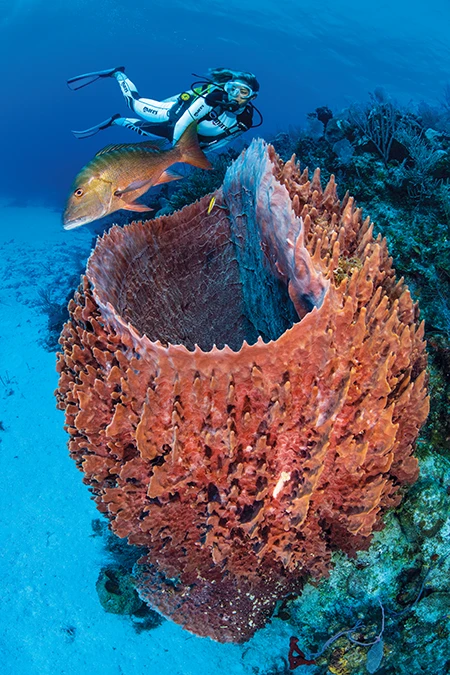
The abundance and variety of subjects are the big draws for me. It is hard to teach techniques when everyone is scratching around for something to shoot or waiting all week for the key species to arrive. Cayman provides plentiful and diverse photographic opportunities and challenges. It is easy to think that Cayman diving is simply divided into walls and shallow reefs, but there is so much more.
The walls will always be star wide-angle attractions, and photographers seek out the shaded north- and northwest-facing walls, where the richly hued sponges grow most spectacularly. The lack of direct sunlight frees the sponges from direct competition with corals, and the moody, silhouetted ramparts create an ideal backdrop for a dramatic reef scene. The plethora of sponges is fabulous for photography, so students have multiple subjects to shoot and no time pressure to hone their techniques.
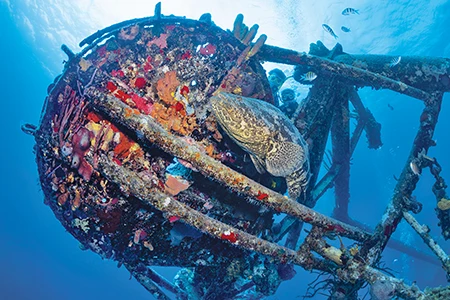
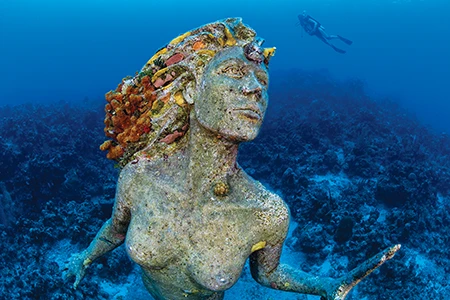
While classic spur-and-groove reefs dominate the shallow sites on the island’s northern and western sides, more three-dimensional reefs with deep canyons and swim-throughs characterize Cayman’s southern and eastern coasts. Classic eastern sites include Ironshore Gardens dan Snapper Hole. The topography enthralls divers and is inspiring and demanding for photographers. The transitional light requires accurate composition and pinpoint camera settings to capture, and it teaches lessons in balancing ambient light that help photographers capture future wreck dives or cenotes.
Both the wall and shallow sites offer plentiful macro subjects. My favorites include characterful tube blennies, mouthbrooding jawfish, and a host of colorful reef fish. For those with an educated eye for spotting, there are several shallow macro sites around the island where you can find seahorses, tiny frogfish, and minute sea slugs.
While not a scuba dive, the Sandbar is an underwater photographer’s dream. Sandbar is the shallower of two Stingray City sites and the one people more commonly visit these days. The traditional Stingray City was often quiet during the pandemic, which extinguished some of the classical conditioning with the rays and bait. Sandbar is now the far more productive of the two, and it’s easier since you can stand up there (fins are not allowed).

The combination of large southern stingrays cruising over white sand and waist-deep, crystal-clear water is irresistible. It is easy to get bucketloads of good photos but much harder to get special shots. The key to more natural images is avoiding the crowds with their handouts for the rays and instead visiting early or late in the day without tidbits. The Sandbar is an ideal place to build a better understanding of working with ambient light underwater and a perfect spot for split-level images when the surface is calm.


Cayman isn’t famous for big animals, but there are more than stingrays. Turtles, especially hawksbills, are common on reef dives. Reef sharks are more plentiful than many people believe, especially off the eastern and northern walls.
Tarpons are one of my choice subjects, although their reflective bodies are hard to shoot well with a flash. They can look particularly beautiful in black-and-white shots using available light. Great schools of tiny silversides swamp a few of the reef’s canyons during the height of summer. These form a living banquet and attract tarpons, jacks, groupers, and snappers to gorge on the ephemeral feast.
The final piece of the puzzle is the newest attraction. The Kittiwake wreck was sunk on Jan. 5, 2011, and has matured into a truly excellent photographic dive. The ship is nicely intact and shallow enough that photographing its structure is an exercise in working the swaths of shadow and detail that transition throughout the day with the sun’s movement. The wreck is ideal for color or black-and-white shooting, and there is no need for a flash to capture such grand vistas.
Head inside the Kittiwake for a mixture of dark and light, frames for fish or divers, and artifacts to illuminate with technical approaches such as off-camera lighting. My groups have nicknamed the Kittiwake the “Wreck of 1,000 Faces” because every photographer who shoots it can find their unique angle.
I explore the Kittiwake, swimming down to peek inside one of the decompression chambers, which is narrow, dark, and guarded by heavy, pressure-resistant hatches. It’s an uninviting space, which reminds me to check my dive computer. The wreck is deeper and bigger than it feels, so my remaining air and no-decompression time signal this dive is ending. I gesture to my buddy that it is time to head back. We are in Cayman after all, so we’ll enjoy a different underwater adventure on the next dive.

My Bountiful Underwater Studio
Grand Cayman is an underwater studio where I have shot multiple catalogs for dive manufacturers over the decades. It has also been the subject of countless destination articles I’ve illustrated for dive media and was my first overseas magazine photo assignment. The same factors attract both Alex and me to work around the island.
Its clear water minimizes backscatter in photos, and the warmth means more comfort for models in swimwear and photographers waiting for an elusive fish behavior to materialize. The dive professionals are skilled in safely and efficiently delivering photo opportunities on stable, seaworthy boats. There is ample diversity in topside lodging options and dining, and the island is extraordinarily accessible via a modern international airport. Customs officials are happy to welcome guests and don’t require a few hundred dollars of duty fees for photographers’ essential camera gear.

By the late 1980s I was on Cayman shooting catalogs for Seaquest and Dacor and later for Scubapro and Subgear. The hook was divers wearing modern dive equipment in an inspiring environment. The placid azure waters lapping a broad expanse of white sand at Seven Mile Beach was a perfect backdrop for topside product illustrations. We shot over/unders of snorkelers in the clear shallow water, topside shots of dive catamarans loading divers from the shore, and sunset shots of divers preparing for a night dive. It was an easy and incredibly photogenic place to shoot, and the beach bar was just a few steps away when we finished the assignment.
Unsurprisingly, I was called upon to shoot mostly underwater images. Grand Cayman offers a wide variety of reef and shipwreck opportunities. A shot of divers with colorful sponges was practically invented on Grand Cayman, where it is supremely easy to take along the western side of the island.
Orange Canyon is one of my favorite sites. Massive orange elephant ear sponges punctuated with red finger sponges provide vibrant foregrounds for the classic diver silhouette. The wall’s face is undercut in many places and decorated with sessile filter feeders, while deepwater gorgonians festoon the promontories that jut seaward into the current. Turtles are common throughout the island, offering opportunities for marine life portraits against a healthy reef background.
Bonnie’s Arch is another West Bay icon. Named for Bonnie Charles, a skilled underwater photographer who died in a dive accident in the early 1980s, the site provides spur-and-groove coral formations that rise from the hardpan at about 20 feet (6 meters), culminating in a mini-wall dropping from 40 to 70 feet (12 to 21 m). The highlight is a natural coral archway about 30-feet (9-m) wide. Tarpons no longer clog the arch, so the colorful tube and elephant sponges decorating the arch’s lower surfaces are now the prevailing attractions. The contrast of the encrusting life’s warm colors with the offshore water’s cobalt blue is quite startling when properly illuminated, which is undoubtedly a strong instructional element for Alex’s groups.

Shipwrecks have long been a part of the Cayman dive scene. The first significant artificial reef along Seven Mile Beach was the Oro Verde, which dates back to 1980. When the freighter was intact, it made a great backdrop for dive fashion. It was an extraordinarily easy dive site and became quite popular, so guides started feeding the resident fish. The early days of feeding at the Oro Verde created daily encounters with a charismatic goliath grouper named Sweetlips. It is now illegal to feed marine life unless specifically permitted by the National Conservation Council, as with the Sandbar stingrays.


Powerful storms have flattened the Oro Verde over the decades, but the wreck still hosts a lot of fish. Enough structure remains to provide a home for resident angelfish, turtles, and often a green moray. It is still a great dive during the day and becomes especially wonderful at night.
Cayman dive operators were on a roll with sinking ships in the early 1980s. In 1982 they successfully sank the Doc Poulson, which sits perfectly upright at 60 feet (18 m). It was an 80-foot (24-m) Japanese cable layer that settled on a bed of white sand, providing a stark contrast with the profusion of colorful sponges, sea fans, and small corals on the wreck.
Panduan LCM David Nicholson is a small landing craft conveniently situated in only 55 feet (17 m) of water. The wreck is moored and accessible by boat or a short swim from the beach entry. While it is too small to occupy a diver for long, yellow tube and purple finger sponges beautifully decorate it and provide significant photo potential.
An advantage of diving from shore is that you inevitably pass the 9-foot (3-m) mermaid statue, Amphitrite. Sculpted by Simon Morris, the statue was placed in 2000 at 55 feet (17 m) and sits only 390 feet (119 m) off the shore.

While you may not be planning to visit Grand Cayman for a photo course or to shoot a dive catalog, the reasons Alex and I have made countless visits there over the years are the same reasons you should consider the island for a dive holiday. It is easy to get to, offers thoroughly professional dive operations, and has topside attractions (including accommodations and dining) that run the gamut from modest to upscale. Whether you do your diving from land or liveaboard, Grand Cayman consistently delivers.
Cara Menyelam
Sampai di sana: The construction project for the new airport terminal was completed in 2019, providing efficient access and a comfortable departure lounge. Cayman Airways and major U.S. carriers such as American, Delta, and United serve the island with direct flights from multiple hubs. Cruise ships are likewise big business, and many cruise ship passengers dive and snorkel with local operators. You’ll likely see them at the Sandbar, so be sure to go early in the day or later in the afternoon after the cruise passengers return to the ships.
Kondisi: Dive sites surround the island, with the most popular on the western, eastern, and northern coasts, providing fine diving in the protected lee of most prevailing winds. It almost doesn’t matter when you plan your Cayman dive holiday. Hurricanes might threaten the island from July through October, but predictions are usually made early if a storm is tracking to the Caymans, so you can rebook your holiday. Water temperatures typically range from 80°F to 86°F (27°C to 30°C). Visibility at most sites is usually 60 to 100 feet (18 to 30 m).
Jelajahi Lebih Lanjut
See more of what Grand Cayman has to offer in this bonus photo gallery and video.
© Alert Diver – Q3 2024
